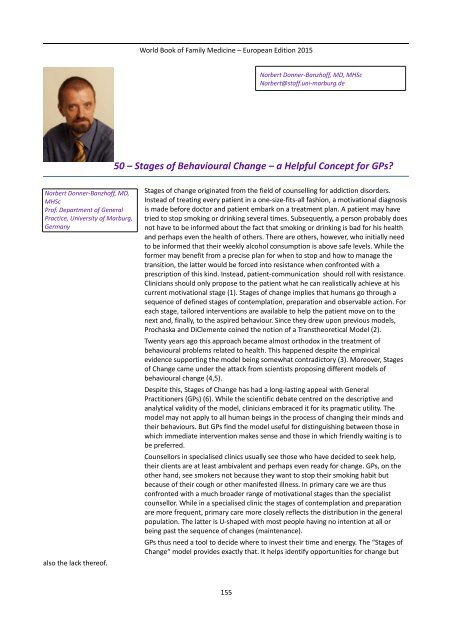Family Medicine
World Book 2015
World Book 2015
You also want an ePaper? Increase the reach of your titles
YUMPU automatically turns print PDFs into web optimized ePapers that Google loves.
World Book of <strong>Family</strong> <strong>Medicine</strong> – European Edition 2015<br />
Norbert Donner-Banzhoff, MD, MHSc<br />
Norbert@staff.uni-marburg.de<br />
50 – Stages of Behavioural Change – a Helpful Concept for GPs?<br />
Norbert Donner-Banzhoff, MD,<br />
MHSc<br />
Prof. Department of General<br />
Practice, University of Marburg,<br />
Germany<br />
also the lack thereof.<br />
Stages of change originated from the field of counselling for addiction disorders.<br />
Instead of treating every patient in a one-size-fits-all fashion, a motivational diagnosis<br />
is made before doctor and patient embark on a treatment plan. A patient may have<br />
tried to stop smoking or drinking several times. Subsequently, a person probably does<br />
not have to be informed about the fact that smoking or drinking is bad for his health<br />
and perhaps even the health of others. There are others, however, who initially need<br />
to be informed that their weekly alcohol consumption is above safe levels. While the<br />
former may benefit from a precise plan for when to stop and how to manage the<br />
transition, the latter would be forced into resistance when confronted with a<br />
prescription of this kind. Instead, patient-communication should roll with resistance.<br />
Clinicians should only propose to the patient what he can realistically achieve at his<br />
current motivational stage (1). Stages of change implies that humans go through a<br />
sequence of defined stages of contemplation, preparation and observable action. For<br />
each stage, tailored interventions are available to help the patient move on to the<br />
next and, finally, to the aspired behaviour. Since they drew upon previous models,<br />
Prochaska and DiClemente coined the notion of a Transtheoretical Model (2).<br />
Twenty years ago this approach became almost orthodox in the treatment of<br />
behavioural problems related to health. This happened despite the empirical<br />
evidence supporting the model being somewhat contradictory (3). Moreover, Stages<br />
of Change came under the attack from scientists proposing different models of<br />
behavioural change (4,5).<br />
Despite this, Stages of Change has had a long-lasting appeal with General<br />
Practitioners (GPs) (6). While the scientific debate centred on the descriptive and<br />
analytical validity of the model, clinicians embraced it for its pragmatic utility. The<br />
model may not apply to all human beings in the process of changing their minds and<br />
their behaviours. But GPs find the model useful for distinguishing between those in<br />
which immediate intervention makes sense and those in which friendly waiting is to<br />
be preferred.<br />
Counsellors in specialised clinics usually see those who have decided to seek help,<br />
their clients are at least ambivalent and perhaps even ready for change. GPs, on the<br />
other hand, see smokers not because they want to stop their smoking habit but<br />
because of their cough or other manifested illness. In primary care we are thus<br />
confronted with a much broader range of motivational stages than the specialist<br />
counsellor. While in a specialised clinic the stages of contemplation and preparation<br />
are more frequent, primary care more closely reflects the distribution in the general<br />
population. The latter is U-shaped with most people having no intention at all or<br />
being past the sequence of changes (maintenance).<br />
GPs thus need a tool to decide where to invest their time and energy. The “Stages of<br />
Change“ model provides exactly that. It helps identify opportunities for change but<br />
155


